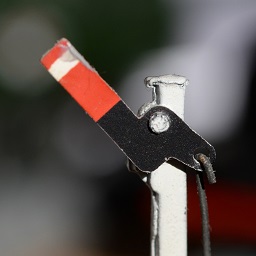
Signalling included a signal box, semaphore signals, two aspect signals and telegraph poles.
The semaphore signal consisted of a post diecast in the white metal alloy zamak. The base of this came with two small holes, to allow pinning down on a permanent layout. On the post was mounted either a red home signal or a yellow distant signal arm. An elaborate design meant that this could be operated by a small handle at the base, which was connected to the arm by a steel wire. Turning the arm could raise or lower the upper-quadrant signal. The post was painted white and the handle was a black plastic. These signals were sold in a pack of three, or a combination of two and a signal box.
Later, a two aspect electric signal was produced. Again, diecast and painted white, with a green and red coloured reflector for the lights. The base came with two small holes, to allow pinning down on a permanent layout. These signals came two in a pack.
The signal box was two stories, with a brick locking room on the ground and a shiplap operating room above. Access to the latter was via an external staircase. The roof was tiled, with a single chimney. Bricks and tiles were painted red, the wooden shiplap and main door was painted white. This was made in the white metal alloy zamak.
Telegraph poles were in a black or latterly brown plastic. These were sold with white trackside fences.










